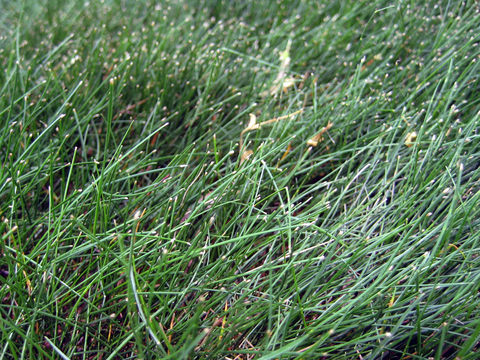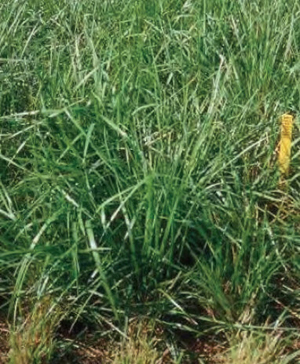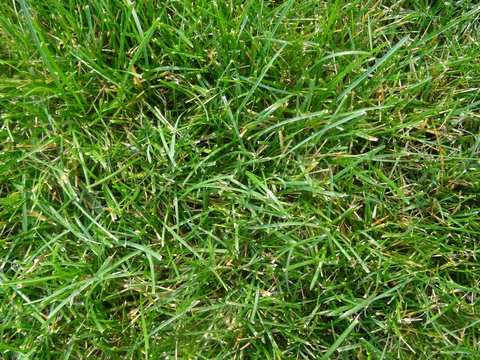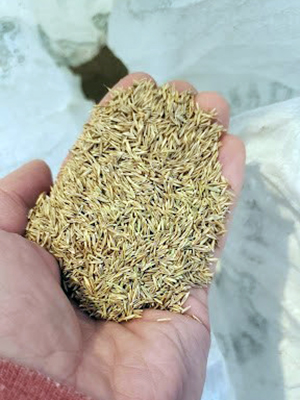Quick facts
- Know which turfgrass species and characteristics you want for your lawn before shopping for seed.
- Seed mixes can contain more than grass seed; make sure you get the seed quality and species you want.
- The seed label on every bag of seed includes important information about the quality of the seed.
Characteristics of Minnesota turf species
Fine fescues
Characteristics
- Includes 5 fescues: strong creeping red, slender creeping red, hard, Chewings, and sheep.
- Drought, shade, and salt-tolerant.
- Often mixed with Kentucky bluegrass.
- Does not do well in extreme heat.
- Called "fine" due to narrow leaf blades.
Maintenance
- Lower maintenance requirements, including less irrigation, mowing, and fertilizing.
- Do not mow in the summer heat.
- Fertilize in the fall if needed for low-maintenance lawns.
Highlights
- A mix of strong creeping red, Chewings, and hard fescue is excellent for home lawns.
- Hard fescue is the most drought-tolerant.
- Strong creeping red and Chewings fescue are the most tolerant of tree shade.
- Sheep fescue = low maintenance.
Tall fescue
Characteristics
- Deep rooting and drought-tolerant.
- Tolerant of wear and traffic.
- Can be used in the shade.
- Slightly coarser than Kentucky bluegrass.
- Slow spring green-up.
Maintenance
- Purchase turf-type tall fescues for lawns.
- Lower maintenance requirement.
- Spring seedings will survive winter better in the first year.
- Do not plant in areas that hold ice in the winter.
Highlights
- One of the most drought-tolerant turfgrasses for Minnesota due to deep, extensive roots.
- Heat and traffic-tolerant.
Kentucky bluegrass
Characteristics
- Dark green appearance.
- Spreading ability with rhizomes.
- May not grow well in shade.
- "Boat-shaped" leaf tip.
Maintenance
- Higher maintenance requirement (fertilizer, water, etc.) than most other cool-season turfgrasses.
- Frequent mowing required.
- May create dense thatch.
Highlights
- Most popular turfgrass in MN
- Has fast recovery
- Used on home lawns, parks, athletic fields, golf courses
- Most widely available species as sod
Perennial ryegrass
Characteristics
- Lacks winter hardiness
- Good wear tolerance
- Pointed leaf tip
- Often produces unsightly stems in the late spring
Maintenance
- Higher maintenance requirement
- Very quick establishment
- Susceptible to many diseases
Highlights
- Used on home lawns, athletic fields, golf courses
- Some perennial ryegrass seed is produced in northern MN
Options for ultra-low maintenance
- Prairie Junegrass, Tufted Hairgrass, Buffalograss
- Natives of North America; use in non-irrigated areas
Options for dense shade
- Supina Bluegrass, Rough Bluegrass
- Prefer areas with plentiful moisture; seed expensive
Download a chart of this information as a PDF.
Purchasing turfgrass seed
Selecting the correct seed for lawn seeding projects can be challenging. Keep these key factors in mind when shopping for grass seed.
Decide which species will grow best in your site conditions
Match your grass species to the amount of light, moisture and soil type of your lawn. Different grass species have different growth requirements, and many are sold as seed mixtures. For more information on Minnesota grass species, watch Turfgrass for Minnesota Lawns.
Make sure you are paying for grass seed
Bags of grass seed often contain more than just seed. Bags of seed can contain inert material, weed seeds, seeds that won’t germinate, and other crop seeds. While some inert material can benefit seed establishment, it can also reduce the amount of true grass seed in the bag.
Single variety, blend or mixture?
Single variety bags consist of one variety of grass seed. Single varieties may be easier to install but can increase maintenance requirements over time due to their susceptibility to disease and pest damage.
Seed blends combine several varieties of the same grass species, whereas seed mixtures contain more than one species. A mixture of multiple species is generally the best for most home lawns.
You get what you pay for
Seed values tend to correlate directly with their price. Seeds with relatively low prices tend to result in poor-quality lawns, while high-priced seeds typically result in high-quality lawns.
Consult local data
Find data on local variety performance of different cultivars on the Cultivar Evaluation Results webpage or use the National Turfgrass Evaluation Program (NTEP). Specific cultivars can be purchased online or from local retailers.
Read the seed label
The label will include information on the percent by weight of seed species or varieties. The label will also contain information related to purity, germination, test date, other crop, weed seed, inert matter, and if any noxious weeds are present.
Preferred range of seed label characteristics
| Label characteristic | Preferred range |
|---|---|
| Purity | >90% |
| Germination | >85% |
| Test date | Within the last 9 months |
| Other crop | <0.5% |
| Weed seed | <0.3% |
| Inert matter | <8% |
| Noxious weeds | None |
Avoid poor grass choices
Some grasses are used in mixtures due to their low cost, including:
- VNS or variety not stated
- ‘Linn’ perennial ryegrass
- ‘Nui’ perennial ryegrass
- Annual ryegrass
- Italian ryegrass
- ‘Common creeper’
Recommended seeding mixtures based on lawn type
| Lawn type** | Kentucky bluegrass | Tall fescue | Fine fescue*** | Seeding rate (lbs/1000ft2) |
|---|---|---|---|---|
| Full sun, regularly watered, high traffic | 100% | - | - | 2 |
| Full sun or some shade, occasional watering, moderate traffic | 10% | 90% | - | 5-7 |
| Some shade, some watering, moderate traffic | 20% | - | 80% | 3-5 |
| Full sun, unwatered, low traffic | - | - | 100% | 3-6 |
| Full sun, unwatered, moderate traffic | - | 100% | - | 7-10 |
| Some shade, unwatered, low traffic | - | - | 100% | 3-6 |
* Perennial ryegrass is often found in seed mixes due to its quick germination and establishment. Try not to have more than 10% perennial ryegrass by weight since it often performs poorly in Minnesota.
**Traffic: Recreation, pets, riding lawnmowers, etc.
***There are five fine fescues that can be used in Minnesota, and it is a good idea to include more than one fine fescue type in a seed mix. For more information on fine fescues, please see Planting and maintaining a fine fescue lawn.
How much grass seed do you need?
Calculate the lawn area you intend to grow. Several free lawn area calculators are available to estimate square footage. Otherwise, you can manually calculate the area by separating your lawn into sections of rectangles and using a measuring tape. The average home lawn in Minnesota is around 19,000 ft2.
Purchase a little extra seed, just in case
When purchasing grass seed, buying 10-20% more than needed to fill areas with poor germination is a good idea. Seed can be kept viable for a few years in a cool, dry place like a sealed 5-gallon bucket.
Purchasing bee lawn seed
A majority of the seed in a bee lawn mix is turfgrass. Fine fescue makes up more than 90% of a bee lawn mix, with the remaining 10% being flower seeds. When purchasing a bee lawn seed mixture, it is important to consider the recommended rate of 4-5 pounds of pure live seed per 1,000 square feet.
An example bee lawn seed mix might consist of approximately:
- Fine fescue - 90-95% (by weight)
- Dutch white clover - 3-5%
- Creeping thyme - 0.5-1.0%
- Self-heal - 2-3%
If purchasing individual seed varieties and creating your own mix, buy Minnesota-adapted varieties.
Find more information about planting and maintaining a bee lawn.
For a list of local vendors and installers of bee lawn seed, visit Bee Lawn Seed and Installation.
Reviewed in 2024





